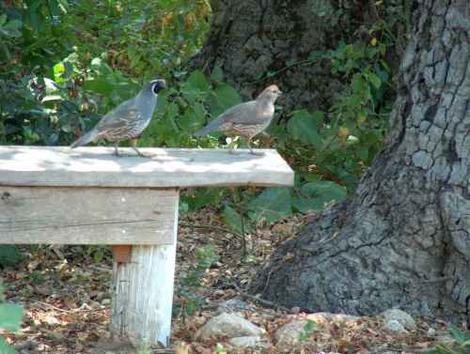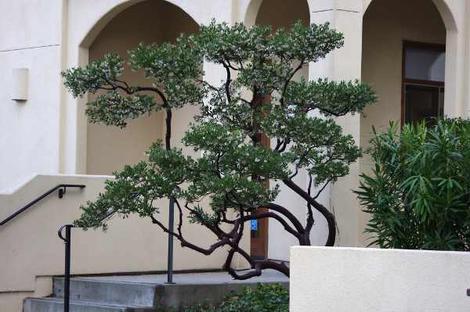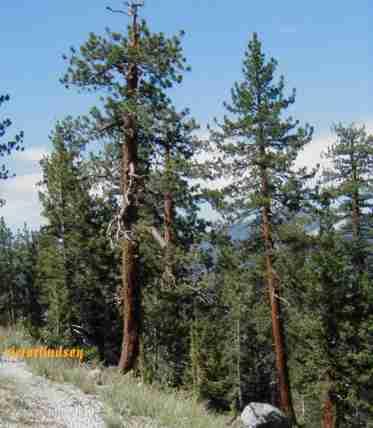How to Design a garden using Native Plants:
A properly designed native garden looks like a formal park or clean, weed free, native ecosystem. This has been very consistent whether the garden, restoration, or landscape is in Mojave, Los Angeles, San Diego, Bakersfield, San Luis Obispo, the Sierras or the Bay area.
The hummingbirds, butterflies, and other small wildlife will love your garden! A native garden is atwitter with the sound of hummingbirds, birds, butterflies and other native insects. This is astounding to people who have a conventional 'hummingbird' garden. A few drunk hummingbirds at a feeder do not make a hummingbird garden. Thirty or so buzzing all over your landscape, telling you off for picking flowers, now that's a hummingbird garden!
Design
If you wish to attempt the landscape design yourself, you can get a list of plants that will grow in your yard from our plant picker. If you can sketch a drawing of your yard with the plants listed out for each section, we'll be happy to help sort out or correct the plant list. Those of you that have read the website (at least a page or two) and used www.mynativeplants with at least a clue of how to care for a native garden are really getting your garden close to 'right' on your own.
In the past 30 years we have provided horticultural and landscape consultation to landscape contractors, landscape architects, landscape designers, botanic gardens, homeowners, and others interested in landscaping. Las Pilitas was started in 1974 in San Luis Obispo specializing in native gardens and in plants utilized by native Californians. You can use us to help you design wildlife gardens (birds and butterflies), California herb gardens, deer (tolerant or for the deer) gardens, fire-resistant gardens, and problem gardens (for example, poor drainage; toxic amounts of salt and/or heavy metals; unhealthy oaks, manzanitas or other natives; very high or low pH; rocky slopes (no soil or minimal amounts); seasonal flooding; low water availability; etc.). Xeriscape and water wise gardens are so easy!!
The basic native garden.
1. Design the garden by plant community as much as possible. Put the desert plants together; the redwood plants together; the riparian (river) plants together; etc. It is a common mistake to landscape by color, textures and flow. ('I want it to flow . . . ') Do that after you figure out what plant community you want to work with. The zip code lists can help determine which plant community was originally on your site.
For an easy carefree landscape, do not get too far off your climate and plant community. Plants from your specific plant community are the easiest to grow. Then the plants from within the nearest communities are next easiest to grow.
2. Stick to the plants that occur in the same or a similar climate for a maintenance free garden. When you get too far off, the plants start having problems and you have to do more work.
3. Figure out the aspect of the garden and the soil, shade, wind, rainfall and any other things that relate to the landscaping. (It will save you many, many hours of your life if you will sit out in the weeds, or whatever else is there) and think the site through before you commit yourself to a scheme that will not work or must be replaced every six months. Most people only have to make this mistake once in a lifetime, but others replace hundreds of dollars worth of 'perennials' each year trying to keep a color scheme while not clashing with the neighbors that are doing the same thing. A lot of money and no fun!
4. Think about your drainage. Where will the water go? How well does the soil drain? Our normal test is how long does it take for a shovelful-sized hole to drain? (When the ground is not wet, e.g., summer.) One minute or less is perfect drainage, 1-30 minutes is good drainage, a week is bad drainage. If your site takes more than a week to drain, you need a consultation! Or at least do some research on your own.
5. If you are installing your own landscaping have a frank talk with yourself. If you are installing one for someone else, talk to them and look at their lifestyle. Are these folks that can work in their garden 2-4 hours each week? Can they afford the gardening bill? Frequently projects have money to put the plants in, but no time or money for follow up. If there is to be no maintenance, put in community specific shrubs and trees, (ones native in that plant community), no perennials and mulch heavily, at least 3 inches. List your priorities. Are deer the biggest problem? Or is it fire? Drought? Budget? Attracting Wildlife(Birds or Bear)? A black thumb?
6. Find a source of proper mulch. Do not use any part of a walnut or eucalyptus tree. (Eucalyptus has some problems with it and can only be used with some plants, e.g., Chaparral. It is best avoided if possible or use as walkways.) If you are using desert plants a mulch of 2-3" rock is fine. (Boulders are better! Next to each plant place the largest rock you can carry and place it on the south side of the plant.)
6a. If you are in the desert or grassland(prairie) and want to plant plants from the Sierras or coastal areas use a leaf, twig, or shredded bark mulch combined with a large rock. The mulch is one of the keys to why things work or do not work in desert gardens. See Read's article for further. If you are in the Sierras(conifer forest) or coastal areas and you want to use a desert or grassland plant, use a rock mulch, and plant in the open, away from trees. Also clump the same types of plants together so they support each other and you can treat them alike, see companion planting.
This also makes it easier to design. Design in a 'forest', a 'desert', a 'prairie', a 'wetland' (wet spot) or whatever community you think will work. Remember this is easiest to do if you stay within the community block.
7. Think about your water source, do you even need water for the plants? Is there any problem with the water? Is there any water even available? We've heard of people spending thousands of dollars on sod lawns only to discover the water bill is hundreds of dollars per month and a maintenance bills hundreds more. Mulch is very cheap in the long run. If you have a lawn area, use plants that live next to the creeks of your target community next to the lawn; water moves through them to your plants in the dry areas.
8. Think about critters. Are you going to live with them or are they going to move in with you? (One of our customers had a bear making himself a fruit salad in his kitchen; another had a deer standing on, on not against, his handrail around his porch. Raccoons on the roof of your mobile home make for little sleep.) Most anything you do has a positive or negative effect on 'Wildlife'. Do you want sparrows or hummingbirds? Gophers or Thrashers? Terrified of ticks and Lyme disease? The bacteria that cause the disease dies when the tick lives on the western fence lizard.(Talleklint and Eisen, 1999; Lane and Anderson. 2001.) A high number of lizards and small mammals in the garden offer near perfect protection. Weeds favor mice (a major vector of disease), mulch and open paths favor lizards. Small mammals (Shrews, Moles, Foxes, Bobcats, Weasels, Squirrels, Gophers, and Rabbits) limit the populations of mice.(Ostfeld and Keesing, 2000)
9. Think of the ultimate plant size. Don't say 'I'll just prune it' and put a redwood tree under a 4' window it won't work. You cannot 'fluff it up', or 'tie it up', or stake it up either. A groundcover tied to a stake looks like a groundcover tied to a stake, not a tree.
10. It is part of our ornamental strategy to plant communities of plants. It is cheaper, looks better, and means less materials consumed. In communities plants are arranged in discrete patterns. This spatial planting occurs naturally, via pathogens and litter (mulch), allowing certain seedlings to grow, killing the weaker seedlings or seedlings that are out of the successional pattern, for the better of the whole. This is how natural succession occurs. When a site is planted incorrectly, the system is weakened, becomes increasingly unstable, and weeds, herbivores (including gophers) take an enormous toll. This won't occur if a design is implemented in a manner consistent with nature. Plant for maturity (leave enough space for the plant when it reaches its full size) with the stress-tolerant species and inter-plant with the Circumventor, C type species for fast fill in. C type species provide cover for the climax stress-tolerants and will decline and die of ‘old age' as the climax species fill-in. Some examples of some Circumventors: Salvias, Ceanothus, Lupinus, Diplacus, Baccharis, Eriogonum and even poppies do this very well.
By doing a natural planting, you can move to a native site faster, lowering inputs sooner. It is important to get your species composition as close as reasonably possible to nature's. Site specific plant material doesn't appear to be practical, nor possible for most sites. (Las Pilitas personnel can do site specific biological surveys, develop the appropriate species list, and contract grow the plants. It will take 1-5 years according to the site.) Planting for the right soil, right community, shade in shade, sun in sun, wet to wet, etc. appears to be more than adequate for the stability of the system and for the site's wildlife. Again, if you live in Los Angeles you can plant species from Chaparral, Southern Oak woodland, and Coastal Sage Scrub communities together and get away with it (as long as the soils, water, sun, etc. match) as the communities were there before the ecosystem was screwed up. The plants would prefer to be in separate groupings, but that's not even necessary. Plants from the yellow pine forest, Closed cone Pine Forest, etc., will grow there, but they are more unstable (weedy, short-lived). It's more important to plant Coastal Sage Scrub species together, even if from other areas of the state, (the further away in climate, the more unsuitable the plant) than mixing other communities that didn't historically exist in your locale. You will spend about 1/10th of the maintenance on the site over a 5-10 year period if you get it right. The maintenance is equal for the first year but then drops off dramatically as the plant community takes hold. You'll know you ‘built a plant community' when the true wildlife start living in your garden (or restoration) and native seedlings start showing up.
10a. Put the perennials together and the shrubs and trees together as they have different needs than annuals. They should be clumped in a way as to be easily maintained. Annuals between are acceptable and encouraged in desert and grassland plant communities. (The weeds will drive you crazy if you do not move aggressively and continually against them.)
If you insist on planting ruderals, plant by age. The short-lived plants go together. Plant the long-lived plants together away from water, away from soil disturbance.
10b. Do not mix annuals with groundcovers, they will become weedy. Annuals are only acceptable where you can mow them down after they die. Otherwise they look like a relative you owe money, a lot of money.
11. Berms are a sign the designer is lazy or doesn't know what to do. They are very hard to maintain, irrigate (on berms you do have to irrigate), and keep the plants alive on. If the berm look is desired, put larger growing plants there, in the center, and work down to smaller ones. If the drainage of a berm is required, use retaining walls with good drain holes so each level is uniform and within 2' of the beginning soil level on either top or bottom (no more than 2' steps)(See "How to build a rock wall").
12. Please, please, pretty please do not put in a fake creek! Fake creeks are hard to build and very hard to maintain. The weeds usually overwhelm the creek in a year or so. A bunch of rocks and weeds does not increase the selling price of a house, nor does an old truck with flowers planted in it, they look similar. A decomposed granite path with boulders, logs and plants can usually create the same feeling with a whole lot less work.














